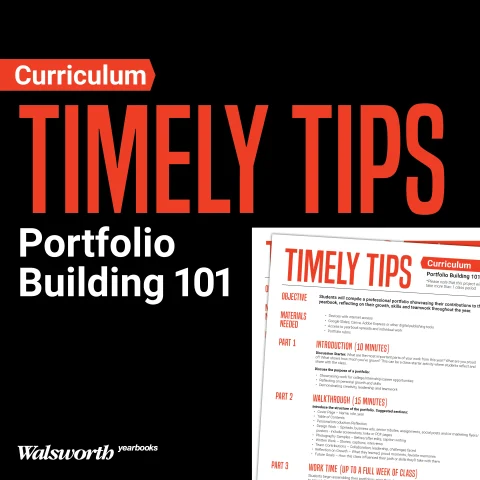When you paint a room, the first thing you do is decide on the look you want, starting with color choice. You buy the paint and make sure you have all of the right tools, like brushes and free stir sticks. You prep the room with drop cloths and masking tape, and only then does the painting begin. When you clean up, you expect to see the room you envisioned.
Creating a yearbook can be compared to painting a room. You and your staff need to think about what look you want to achieve; check your tools; plan and do your prep work. Then create. If all of those things have been done to your plan, you and your staff should have the book you envisioned.
So, let’s take those four steps above, rearrange them slightly and break them down further, to help guide you as you prepare to create a well-designed yearbook that will tell the story of the year.
Prep work
Budgets figure into redecorating, and it’s the same with yearbook. Look at your expenses and income from last year, and work up a budget for this year. Your best budget resource is your yearbook sales representative. They can help you determine what you can afford and even look at ways to increase revenue or spend more wisely to get that hot foil treatment on the cover.
Individual pictures of underclassmen, faculty and staff are taken on Portrait Day and Retake Day. These two days occur early in the fall, and should have been scheduled with your school’s professional photographer already. If not, get them on the school calendar now. Do not schedule them on a Monday or Friday (the days with the most absences), and make sure they do not conflict with other activities on the school calendar.
Your staff needs to be busy with several activities before school starts or early in the year. One of those is sales. The best way to pay for your yearbook is by selling your yearbook and ads, not candy or car washes. Take book orders at registration, have a back-to-school special for one week in September. Also, organize sales teams to sell ads to businesses and advertise recognition ads to parents. The school website, letters and phone calls utilizing your school’s automated system are useful in getting the word out.
Editors need training for their leadership roles. If they did not attend a summer workshop, consider spending a day with them to impart these skills. Remember, yearbook is a student publication. Their job is to create it, and your job is to advise them.
If your staff did not attend a summer workshop, or even if they did, you should consider a one-day fall workshop to let editors finalize staff organization and work with them so everyone understands their jobs. Ask your yearbook sales representative to lead the workshop and provide training in design and the technology you are using (Adobe InDesign, Adobe Photoshop and/or an online creation program such as Walsworth’s Online Design).
Tools
Check to make sure your equipment is working and your supplies are in hand. Start with your computers, their hard drives and the network. Work with your network administrator on these topics, and to make sure you have all of your software properly loaded or that your system will easily handle the online creation program.
Check that the cameras are in working order. If you are not using digital, have plenty of film and batteries on hand, an equipped darkroom, a film scanner or an agreement with a developer, and an image scanner. If using digital, have plenty of batteries and memory cards. Have an image file management system in place that your photographers will use to upload images so they can be easily found.
With painting a room and yearbook, you need a ladder. Only in the case of yearbook, a ladder is a blueprint of coverage for each page of the book. Have your staff make a list of everything that must be in the yearbook – homecoming, sports, plays, portraits, ads and more – and decide on what pages to place these topics. Do not forget pages for the opening, closing, divisions, table of contents and title page. Post your ladder on the classroom wall, give you and your staff individual copies and post it online.
Figure out your deadlines. Using the deadline dates agreed to with your yearbook publisher, determine mini-deadlines for first draft and rewrites of articles, photos, spread design and proofing. Then put all of the deadlines on a poster and hang it up in the classroom.
Begin to create
Your editors will need time to brainstorm and come up with a theme, cover, colors, fonts, endsheets and division pages. During a brainstorming session, no idea is rejected or commented on; when brainstorming is done, then ideas are discussed to pare them down to the best one. Brainstorming is done during a summer workshop, but it also can be done during meetings before school starts, work sessions after school starts or a fall workshop.
Your editors need to develop a staff manual if one has not been created. The staff manual is a guide for all of the rules of the year. Some things to include are syllabuses, job descriptions, mission statement, grading policy, contact information, school calendar, ladder, deadlines, style guide for spelling (start with the AP Stylebook), camera checkout policy, fonts, colors and graphic elements for this year’s yearbook and obituary guidelines.
Your photographers should be working as there are many sports-related activities going on before the first day of school, such as football practice and marching band practice. This is also a great time to let your new photographers learn and practice.
If yearbook is a class, have a grading system in place. There are an infinite number of ways to evaluate student work, so just come up with one that will work for you. Consider a checklist in which each major task is awarded points.
Lastly, while Ace is the Place for the Helpful Hardware Man, you also need some place to turn to for assistance, mentoring and learning. There are state, regional and national scholastic organizations that provide these opportunities for you and your students. Remember, you are the only yearbook adviser in your school; to find people who understand your job, you must look outside of your school building. Start at the Journalism Education Association at jea.org and the National Scholastic Press Association at studentpress.org/nspa. JEA is a support organization for journalism teachers and advisers, while NSPA provides assistance and education for both advisers and students.



